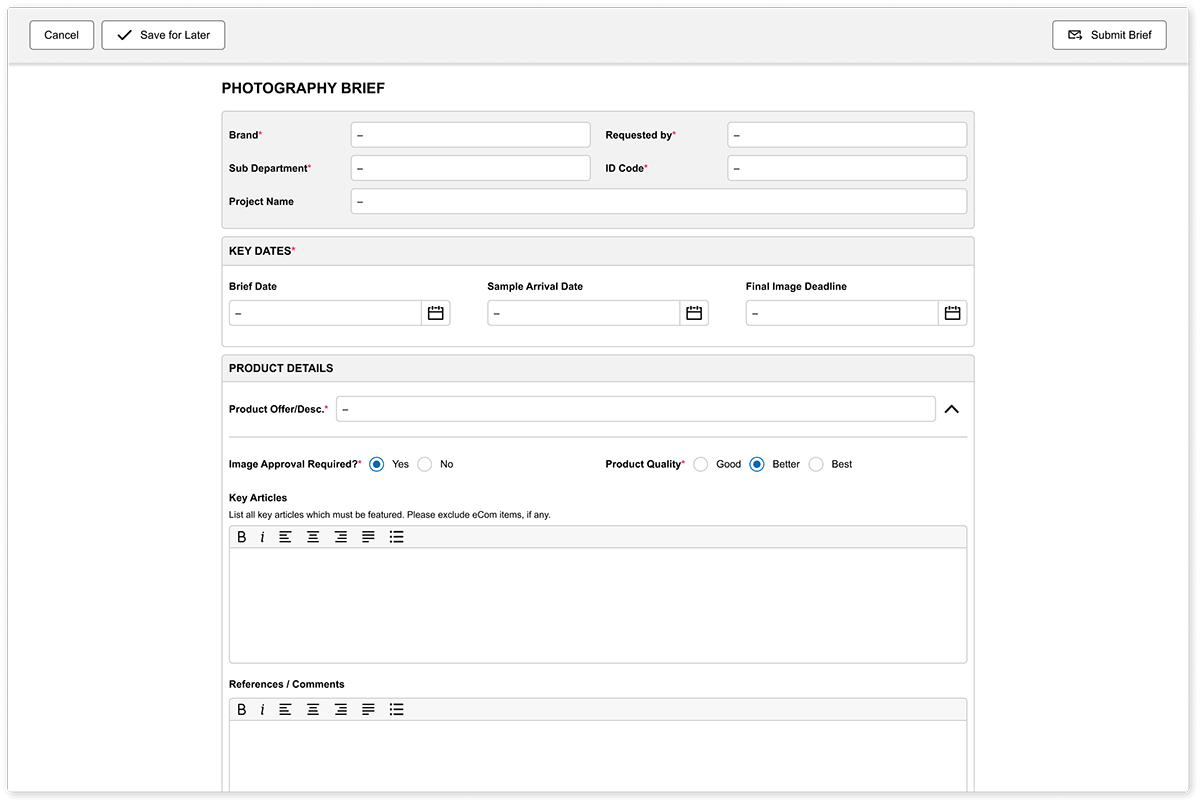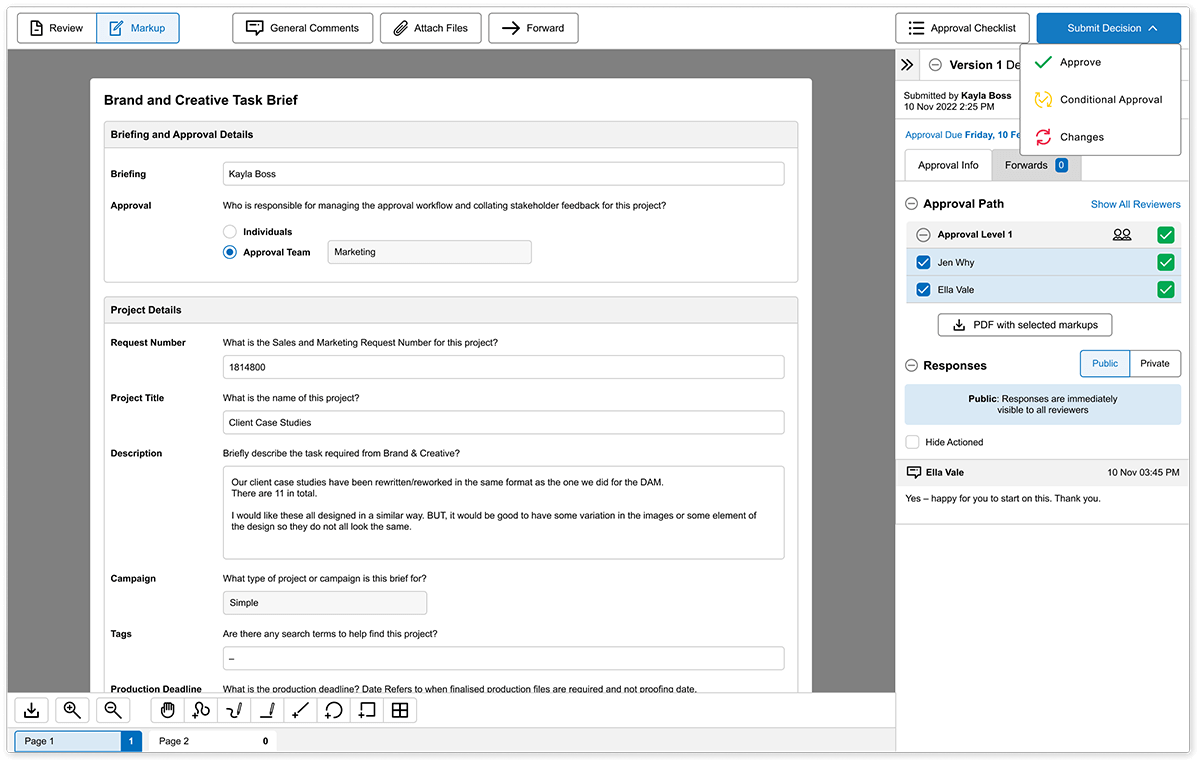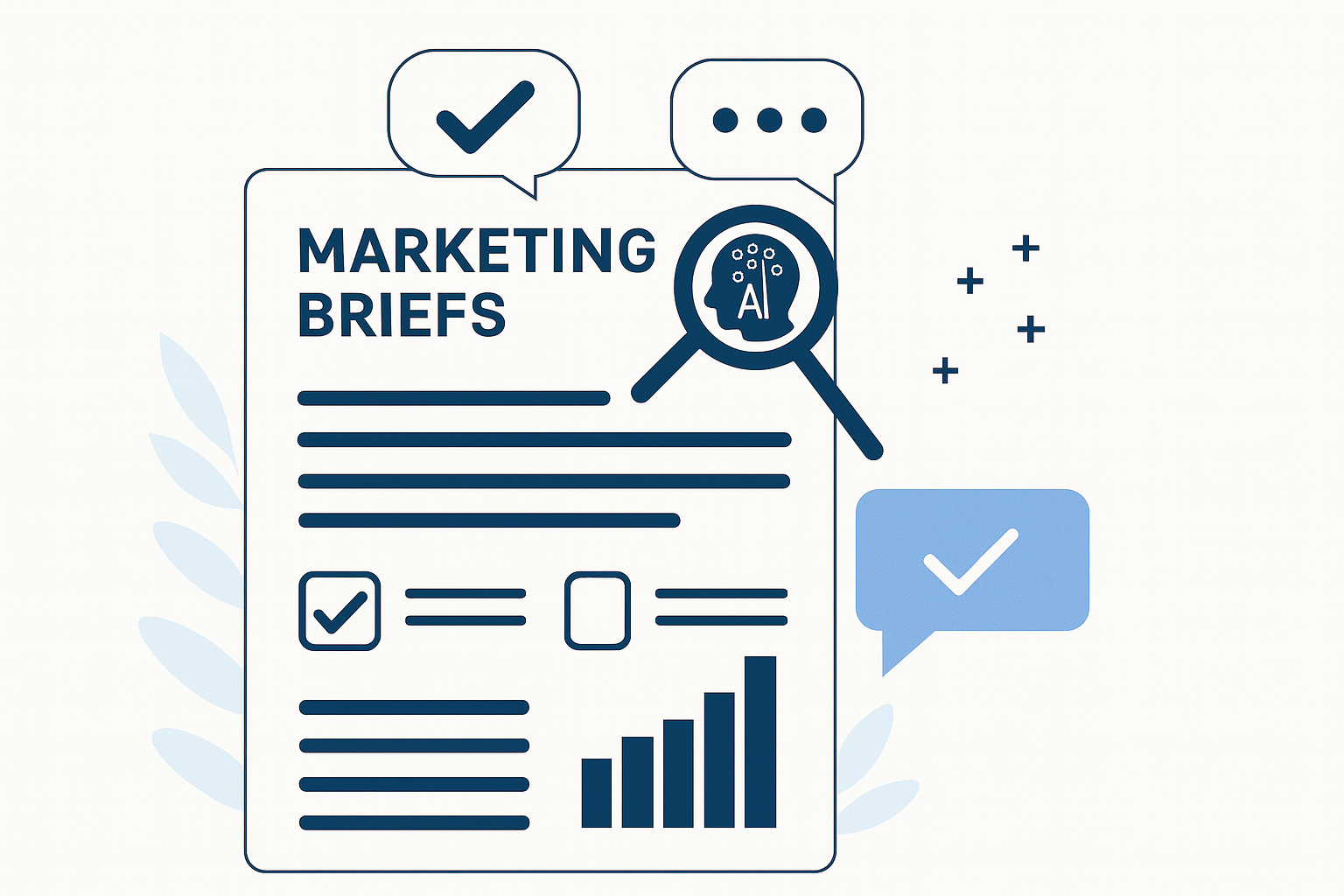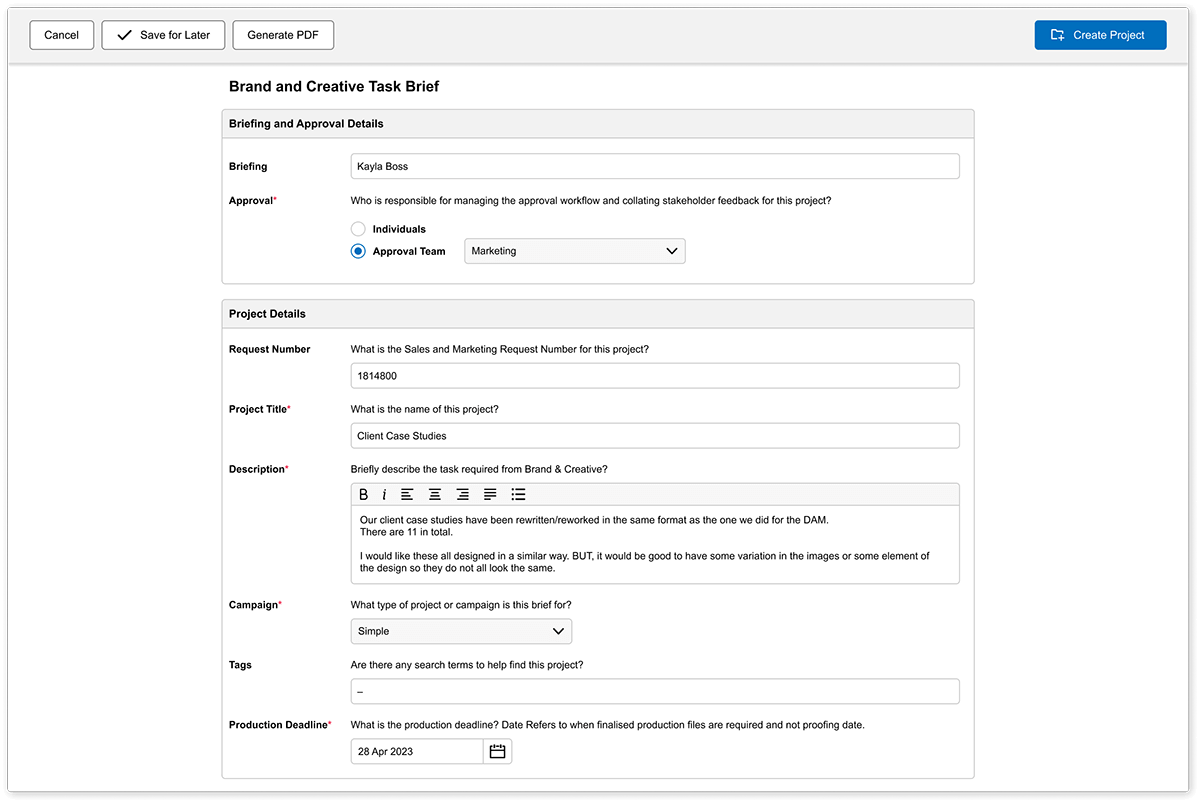Stop Wasting Time on Bad Briefs | Smarter Marketing Project Management and AI Insights
The creative brief isn’t just paperwork; it’s the cornerstone of your marketing project. Yet, briefing often turns out to be a challenge even for seasoned professionals. A well-written brief should confidently leverage creative and strategic assets, allowing for a more organic and impactful creative outcome without excessive control.
Bad briefs are a common issue in creative projects—lacking focus and clarity, they can hinder creativity, cause confusion, and ultimately impede campaign success.
A startling study shows that 30% of agencies’ wasted time is caused by poor client briefing. That inefficiency translates into more than just lost time—it affects project management, drains resources, and slows down your go-to-market strategy. Clear communication and collaboration between brands and their agency partners are essential to avoid these pitfalls. Clients are also essential stakeholders whose input and collaboration are crucial for effective briefing. If you find yourself bogged down by ineffective briefing habits, it’s time to rethink how you manage briefs for a better creative workflow and more efficient marketing project management.
Introduction to Creative Briefs
A creative brief is the essential starting point for any successful creative project. Acting as a roadmap, a creative brief brings together all stakeholders—marketing teams, creative teams, and business leaders—ensuring everyone is on the same page from the outset. This foundational document outlines the project’s objectives, timeline, stakeholders, and deliverables, providing a clear structure for the creative work ahead.
Writing a good creative brief is a collaborative process that helps align project objectives and expectations. When creative briefs are well-written, they streamline processes, reduce confusion, and set the stage for effective creative outcomes. Whether you’re launching a new campaign or developing a brand asset, a comprehensive creative brief ensures that the target audience and business goals are clearly defined.
For those looking to simplify the process, downloadable creative brief templates are available to guide you in creating briefs for a variety of projects. A good creative brief is not only thorough and descriptive but also easy to read, making it an indispensable tool for any business or creative team.
The Cost of Bad Briefing: By the Numbers
While the creative brief is widely recognised as a vital tool, it’s often neglected. Both marketers and agencies agree that a well-crafted brief is key to producing quality work, yet there’s a consistent gap in execution.
- The Brief’s Value and Neglect: 90% of marketers and 92% of agencies agree the brief is one of the most valuable—but also most neglected—tools for generating quality output.
- Difficulty in Brief Writing: 82% of marketers and 83% of agencies say writing an effective brief is challenging.
- The Perception Gap: 80% of marketers believe they write good briefs, while only 10% of agencies agree.
- Understanding Requirements: 80% of agencies believe marketers have a limited understanding of what a good brief requires.
- Brief Changes: 90% of marketers admit their briefs are modified after submission.
- Rebriefing Impact: 43% acknowledge time lost, and 18% identify increased costs due to rebriefing.
- Financial Cost: Nearly one-third of marketing budgets are wasted on poorly crafted briefs and misdirected work, leading to unnecessary spending and inefficient resource allocation.
These statistics underscore the need for a more structured, aligned briefing process — something Admation’s marketing project management software was built to deliver. (Source: Better Briefs Global Report)
Why Good Briefs Matter
A good brief is the foundation of every successful campaign. It connects strategy to execution, ensuring everyone works towards the same objectives. A clear, well-structured brief drives creativity, consistency, and results — while a poor one wastes time, limits innovation, and causes misalignment. A poor brief can also lead to misunderstandings, wasted resources, and even project failure, making it essential to invest time in crafting a comprehensive and effective brief.
The Role of the Marketing Team
The marketing team plays a pivotal role in crafting a creative brief that sets the stage for great creative work. By providing clear direction while allowing creative teams the freedom to innovate, marketers help bridge the gap between strategy and execution. Understanding the components of a successful creative brief—such as brand positioning, brand idea, and brand plan—enables marketing teams to make smarter decisions and elevate the quality of their campaigns.
A well-developed creative brief is rooted in a solid brand communications strategy, ensuring that every project aligns with the broader goals of the business. The marketing team’s expertise in creating and refining briefs is crucial for inspiring creative teams and driving effective advertising and marketing initiatives. Ultimately, the creative brief serves as the link that connects strategic vision to creative execution, empowering teams to deliver great creative results.
How to Improve the Creative Briefing Process: A Structured Approach
Focusing on clear business outcomes, not just creative direction, helps ensure your message resonates and your team stays aligned.
Additionally, discussing the brief with all relevant stakeholders, including colleagues and agencies, is essential to avoid miscommunication and ensure clarity throughout the project.
Bring More Structure to the Briefing Process
More than 70% of marketers say project briefings could be vastly improved with a more structured approach. Admationprovides tailored online briefing forms that capture every essential detail — budgets, milestones, keywords, and objectives — upfront. Using a template or briefing form ensures that all necessary project information is collected consistently, reducing the risk of missing key details.
Benefits:
- Improved stakeholder alignment
- Fewer post-brief clarifications
Ensure the Right Sign-offs Internally
Without the right approvals, projects stall and require costly rework. Admation’s brief approvals feature ensures each brief is reviewed and approved by the right people before production begins.
Benefits:
- Prevents bottlenecks early
- Reduces rebriefing and wasted effort
Using AI to Craft Better Marketing Briefs – and Knowing Its Limits
Artificial intelligence is transforming marketing workflows, and many teams are now using tools such as ChatGPT, Jasper, and Copy.ai to assist in writing and refining briefs. When used strategically, AI can improve clarity, speed, and idea generation. These tools can also help teams develop their marketing expertise and decision-making abilities, leading to stronger creative work and business growth — but it also comes with risks that marketers must manage carefully.
(According to Adobe’s 2024 Digital Trends Report, 74% of creatives believe AI can enhance collaboration, but most still view it as a support tool, not a replacement.)
How to Use AI to Strengthen Your Brief
AI can streamline early stages of the briefing process and help marketers refine their thinking.
- Generate first-draft ideas: Use AI to turn bullet points or notes into a structured first draft.
- Clarify tone and objectives: Prompt AI to simplify complex messaging or ensure your language is audience-appropriate.
- Benchmark past work: Ask AI to summarise key insights from previous campaigns or reports to strengthen context.
- Create reusable templates: Build prompt-based templates that ensure consistency in structure and content across campaign types.
- Tip: Review and personalize AI-generated drafts to ensure they align with your brand voice and project goals for maximum effectiveness.
These uses can help marketers spend less time on admin and more time managing creative projects strategically.
The Risks of Over-reliance on AI
AI isn’t a replacement for human judgment, stakeholder collaboration, or creative intuition. Over-reliance on AI in marketing briefs can create serious gaps.
- Generic or formulaic output: AI can default to “safe” ideas that lack creativity.
- Brand inconsistency: Without brand tone and compliance rules, AI can stray from established guidelines.
- Data and confidentiality risks: Entering sensitive campaign information into public AI tools can compromise security.
- Lack of ownership: AI doesn’t replace stakeholder buy-in or accountability.
AI works best as a co-pilot — a tool for exploration and structure, not authorship.
Why Integrated AI Isn’t Essential
Some marketing project management software tools are embedding AI to automate brief creation. While this might seem useful, it’s not necessary for producing great results.
Teams can achieves the same benefits through structured templates, mandatory fields, and multi-user approval workflows — helping teams maintain accuracy, compliance, and collaboration without relying on AI. With these structured processes, significant milestones and successful outcomes are achieved, ensuring project objectives are met efficiently.
You can still use external AI tools to refine your thinking and paste that content into an online briefs. This way, marketers retain full control over data, creative quality, and approval workflows — the core of effective marketing project management.
Measuring the ROI of Better Marketing Briefs
Improving the quality of marketing briefs isn’t just about saving time — it directly impacts campaign performance and ROI. Poor briefing leads to duplicated effort, missed deadlines, and creative that misses the mark. By contrast, clear, structured briefs help teams launch faster and deliver stronger results.
For example, a marketing team that adopted a structured brief template saw a 20% increase in campaign ROI by ensuring all stakeholders were aligned from the start.
According to HubSpot’s 2024 State of Marketing Report, teams with consistent briefing processes are 38% more likely to meet campaign KPIs and report 27% higher satisfaction among stakeholders.
How Structured Briefing Delivers ROI:
- Fewer revisions: Clearer briefs mean fewer approval cycles and reduced creative rework, saving both time and money by minimizing unnecessary resource spend.
- Faster campaign delivery: Centralised workflows reduce delays between brief, review, and launch.
- Improved compliance: With every required field captured, teams avoid brand and legal risks.
- Higher creative impact: Creative teams spend more time developing ideas and less time clarifying direction.
Quick Fact:
Gartner’s 2024 Marketing Technology Survey found that 56% of CMOs cite poor briefing and feedback loops as top barriers to marketing effectiveness.
With Admation’s project management tools, marketers can measure process improvements and time savings directly. Built-in dashboards and approval histories provide visibility into time spent per project, turnaround rates, and efficiency gains.
This helps marketing operations leaders not only manage creative projects but also demonstrate the tangible business value of streamlined briefing and marketing approval workflows.
Key Elements of a Smart Brief
A smart brief is clear, concise, and strategic, and should include the following elements as key components. It defines the campaign objective, target audience (including the qualities they value or dislike), key message, desired outcome, and creative direction. It articulates the brand’s value proposition and emotional connection while guiding the creative team without over-specifying execution.
Including up-to-date brand guidelines in the brief is essential to ensure consistent branding and provide clarity on the brand’s voice, tone, and creative expectations.
Solving Business Problems with a Creative Brief
A creative brief is more than just a project outline—it’s a powerful tool for solving business problems. By clearly defining the project’s objectives, target audience, and key messages, a creative brief ensures that all stakeholders are aligned and working toward a common goal. This focus allows the creative team to concentrate on developing effective creative work that addresses the most important information and delivers real business impact.
Including relevant data and insights in the creative brief provides valuable context, helping the creative team gain a better understanding of the target market. This in-depth guidance enables teams to identify opportunities, refine messaging, and create advertising and marketing campaigns that truly resonate. When a creative brief is well-written and focused, it becomes the foundation for developing creative solutions that drive business success.
Managing Briefs Made Easy with Admation
Incorporating features specifically designed to make briefing as efficient and effective as possible, Admation transforms how marketing teams manage their creative projects. As a single platform, Admation allows users to manage all creative and design tasks in one unified environment, streamlining workflows and centralising project management. By streamlining the process, Admation ensures that every creative brief is complete, compliant, and ready to drive impactful outcomes.
Here’s a closer look at the six ways Admation enhances this critical marketing activity:
1. Online Briefs: Customisable for Your Creative Team and Project Types
Gone are the days of fragmented conversations and incomplete briefs buried in emails. Admation’s online briefing formsare tailored to your organisation and project types — whether it’s a social campaign, brand awareness initiative, retail rollout, or an online course.
These comprehensive customised forms capture all essential information, including project overviews, budgets, milestones, deliverables, keywords, audiences, and attachments. This structured approach minimises guesswork and time-consuming back-and-forths, setting the stage for success.
Benefits:
- Enhanced collaboration and clarity across marketing, creative teams and other stakeholders
- Faster setup for projects with reduced miscommunication
- Better accuracy in capturing marketing objectives

2. Briefing Templates: Streamline Your Creative Process
Admation’s briefing templates allow marketers to create reusable templates for recurring campaign types. This ensures consistency in tone, structure, and data entry across the team — a time-saver that improves efficiency and quality.
Benefits:
- Increased efficiency when initiating new campaigns
- Consistent brief content across departments and regions
- Simplified setup for frequently repeated project types
Here are a few tips for maximising the effectiveness of your briefing templates: regularly review and update templates to reflect changing needs, involve key stakeholders in the template design process, and provide clear instructions for each section to ensure accurate and complete information.
3. Centralise, Re-Use, and Duplicate Information: Your One-Stop Hub
Admation functions as a centralised platform for all project-related documentation, including creative briefs, marketing approvals. Beyond centralisation, the platform enables teams to duplicate approved or completed briefs, then update them for new campaigns with revised dates, deliverables, or audiences.
This eliminates rework and ensures continuity of successful campaign frameworks.
Benefits:
- Streamlined access to current and past briefs for easy reference
- Easy storage and reuse of company background information for consistent messaging
- Improved accountability with clear version history
- Faster campaign turnaround and collaboration across teams
You can learn more about how Admation supports campaign re-use and version management in Spreadsheet View: Managing High-Volume Campaigns Efficiently.
4. Auto-Generate Projects: Say Goodbye to Manual Re-Entries
Once a brief is approved, Admation can automatically generate a new project based on its details. This means your creative or production teams don’t need to manually re-enter data, the project setup happens instantly with all relevant fields already populated.
It’s especially powerful for teams producing multi-format deliverables (e.g. 30-second TV ads, digital banners, print versions, or a landing page) where campaign data consistency is essential.
Benefits:
- Rapid transition from brief approval to project start
- Reduced manual data entry errors
- Significant time savings redirected toward creative and strategic tasks
5. Creative Brief Approvals: Collaborate and Validate
Admation streamlines brief approvals with built-in workflows that allow nominated stakeholders — from marketing managers to legal reviewers to comment, review, and approve directly within the platform. Admation also facilitates collaboration and approvals with external creative agency partners, ensuring all creative agencies involved can contribute and align on the creative brief.
This removes the need for external approval chains or scattered feedback threads and ensures consensus before creative work begins.
Benefits:
- Quick and transparent approval cycles
- Stronger collaboration and accountability
- Reduced risk of artwork revisions and rebriefing
Admation’s Approval Workflow Management module integrates seamlessly with the briefing process, supporting compliance, transparency, and audit readiness.

6. Accuracy and Control: Mandatory Fields for Full Compliance
Admation’s mandatory fields within its briefing templates ensure that no key details are overlooked — from disclaimers and legal statements to brand tone or regulatory notes. By requiring essential information, these fields help brands maintain consistency across all creative outputs. This built-in quality control helps marketing teams maintain both brand consistency and marketing compliance.
Benefits:
- Fully completed briefs every time — no gaps or missing context
- Strengthened compliance with industry and internal requirements
- Fewer project delays caused by incomplete or inaccurate briefs
To understand how these features support marketing compliance, explore Marketing Compliance Guidelines.
Why This Matters
With these benefits combined, Admation delivers a 360-degree approach to marketing project management, ensuring every project brief is complete, approved, and ready for execution. Companies of all sizes can benefit from Admation's comprehensive project management features, streamlining processes and enhancing collaboration across teams.
Whether you’re managing high-volume retail campaigns or complex multi-stakeholder creative projects, Admation’s platform empowers your team to manage creative projects, improve marketing approvals, and maintain compliance— without sacrificing speed or control.
Examples of Creative Briefs
There are countless creative brief examples available, each tailored to different project needs and objectives. Using a creative brief template can help guide the writing process, ensuring that all the essential elements are included for a well-structured and effective brief. A strong template typically covers the project title, project objectives, target audience, key messages, and desired outcomes, along with a concise summary and any relevant background or context.
By leveraging a creative brief template, marketers and designers can streamline the process of creating briefs, maintain consistency across projects, and ensure that every brief is focused and comprehensive. Reviewing creative brief examples can also provide inspiration and clarity, helping teams understand how to best present information and set their projects up for success.
The Impact of a Great Creative
A great creative brief can make all the difference in the success of a project. By providing clear direction and focus, it empowers the creative team to deliver their best work while ensuring that all stakeholders are aligned and working toward shared project objectives. A well-written creative brief serves as a framework for evaluating creative work, reducing the risk of poor briefs that can lead to frustration, inefficiency, and missed opportunities.
Investing time and effort into creating a great creative brief pays off by setting the foundation for good creative and great creative outcomes. Marketers and designers who prioritize the briefing process are better equipped to achieve their goals, drive project success, and deliver impactful advertising and marketing campaigns. In short, a good creative brief is not just a formality, it’s a critical component of any high-performing creative team.
Common Mistakes to Avoid
Avoid overly long, vague, or overly prescriptive briefs. Including too many messages in a brief can overwhelm your audience and reduce campaign effectiveness—focus on a single core message. Define your audience clearly, keep it concise, and collaborate with all stakeholders before submission.
Read more on improving collaboration in our blog, How to Take the Pain Out of Managing Marketing Requests.
How Admation Can Help
Admation is a marketing workflow and project management solution that helps teams centralise briefs, streamline approvals, and improve collaboration. By eliminating the chaos of email-based briefing and introducing structured forms and approval workflows, it ensures everyone stays aligned. Admation enables teams to clearly describe project requirements and expectations, ensuring that all stakeholders have a shared understanding from the outset.
In a landscape where inefficient briefing costs time and budget, Admation delivers structure, clarity, and control — helping marketing teams manage creative projects with confidence.
For teams managing multiple stakeholders, compliance steps, and creative workflows, Admation’s integrated platform provides the visibility and accountability that every marketing operation needs.
Related Reading
Conclusion
The financial and operational costs of poor briefing are too high to ignore. With Admation, you’re not just implementing a tool — you’re enabling a smarter, more consistent approach to marketing project management.
Don’t let poor briefing slow down your campaigns. Discover how Admation can streamline your marketing approvals and creative workflow : Explore Admation on Simple.io


